
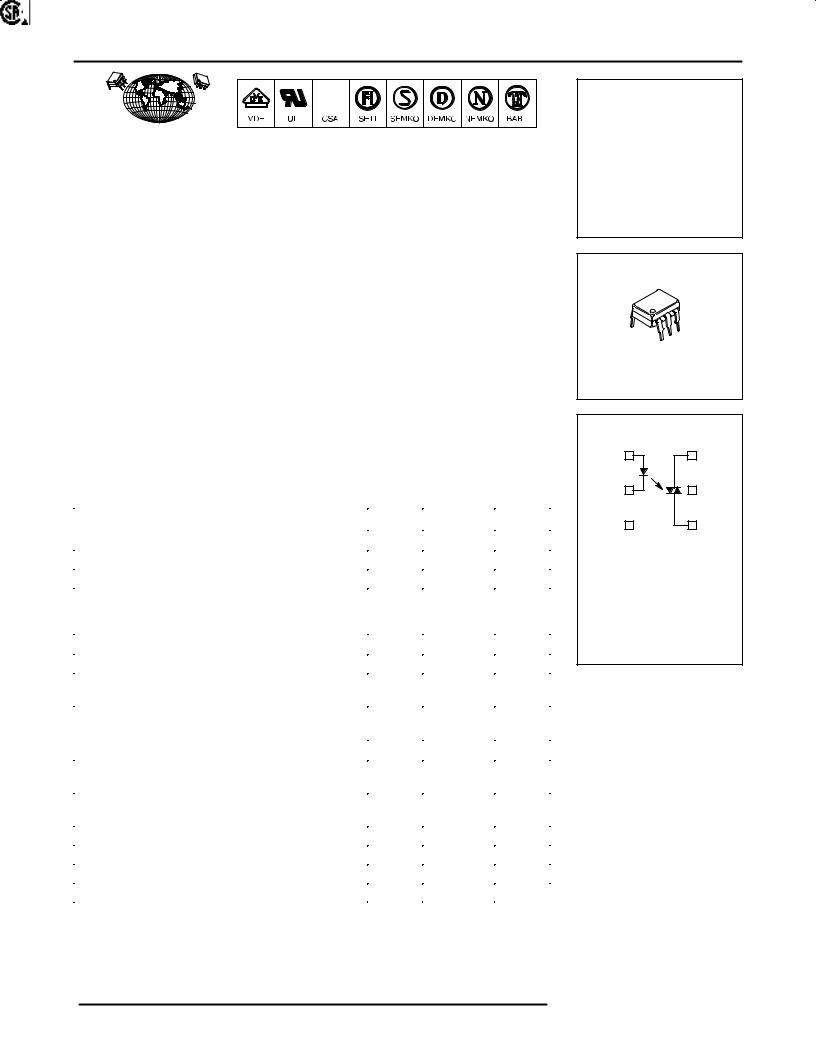
MOTOROLA
SEMICONDUCTOR TECHNICAL DATA
Order this document by MOC3010/D
GlobalOptoisolator |
6-Pin DIP Random-Phase
Optoisolators Triac Driver Output
(250 Volts Peak)
The MOC3010 Series consists of gallium arsenide infrared emitting diodes, optically coupled to silicon bilateral switch and are designed for applications requiring isolated triac triggering, low±current isolated ac switching, high electrical isolation (to 7500 Vac peak), high detector standoff voltage, small size, and low cost.
•To order devices that are tested and marked per VDE 0884 requirements, the suffix ºVº must be included at end of part number. VDE 0884 is a test option.
Recommended for 115 Vac(rms) Applications:
•Solenoid/Valve Controls
•Lamp Ballasts
•Interfacing Microprocessors to 115 Vac Peripherals
•Motor Controls
•Static ac Power Switch
•Solid State Relays
•Incandescent Lamp Dimmers
MAXIMUM RATINGS (TA = 25°C unless otherwise noted)
Rating |
Symbol |
Value |
Unit |
|
|
|
|
INFRARED EMITTING DIODE |
|
|
|
|
|
|
|
Reverse Voltage |
VR |
3 |
Volts |
Forward Current Ð Continuous |
IF |
60 |
mA |
Total Power Dissipation @ TA = 25°C |
PD |
100 |
mW |
Negligible Power in Transistor |
|
|
|
Derate above 25°C |
|
1.33 |
mW/°C |
|
|
|
|
OUTPUT DRIVER |
|
|
|
|
|
|
|
Off±State Output Terminal Voltage |
VDRM |
250 |
Volts |
Peak Repetitive Surge Current |
ITSM |
1 |
A |
(PW = 1 ms, 120 pps) |
|
|
|
|
|
|
|
Total Power Dissipation @ TA = 25°C |
PD |
300 |
mW |
Derate above 25°C |
|
4 |
mW/°C |
|
|
|
|
TOTAL DEVICE |
|
|
|
|
|
|
|
Isolation Surge Voltage(1) |
VISO |
7500 |
Vac(pk) |
(Peak ac Voltage, 60 Hz, 1 Second Duration) |
|
|
|
|
|
|
|
Total Power Dissipation @ TA = 25°C |
PD |
330 |
mW |
Derate above 25°C |
|
4.4 |
mW/°C |
|
|
|
|
Junction Temperature Range |
TJ |
± 40 to +100 |
°C |
Ambient Operating Temperature Range(2) |
T |
± 40 to +85 |
°C |
|
A |
|
|
Storage Temperature Range(2) |
T |
± 40 to +150 |
°C |
|
stg |
|
|
Soldering Temperature (10 s) |
TL |
260 |
°C |
1.Isolation surge voltage, VISO, is an internal device dielectric breakdown rating.
1.For this test, Pins 1 and 2 are common, and Pins 4, 5 and 6 are common.
2.Refer to Quality and Reliability Section in Opto Data Book for information on test conditions.
Preferred devices are Motorola recommended choices for future use and best overall value.
GlobalOptoisolator is a trademark of Motorola, Inc.
(Replaces MOC3009/D)
MOC3010
[IFT = 15 mA Max]
MOC3011
[IFT = 10 mA Max]
MOC3012*
[IFT = 5 mA Max]
*Motorola Preferred Device
STYLE 6 PLASTIC
6
1
STANDARD THRU HOLE
CASE 730A±04
COUPLER SCHEMATIC
1 |
6 |
2 |
5 |
3 |
4 |
1.ANODE
2.CATHODE
3.NC
4.MAIN TERMINAL
5.SUBSTRATE
DO NOT CONNECT
6.MAIN TERMINAL
Motorola, Inc. 1995
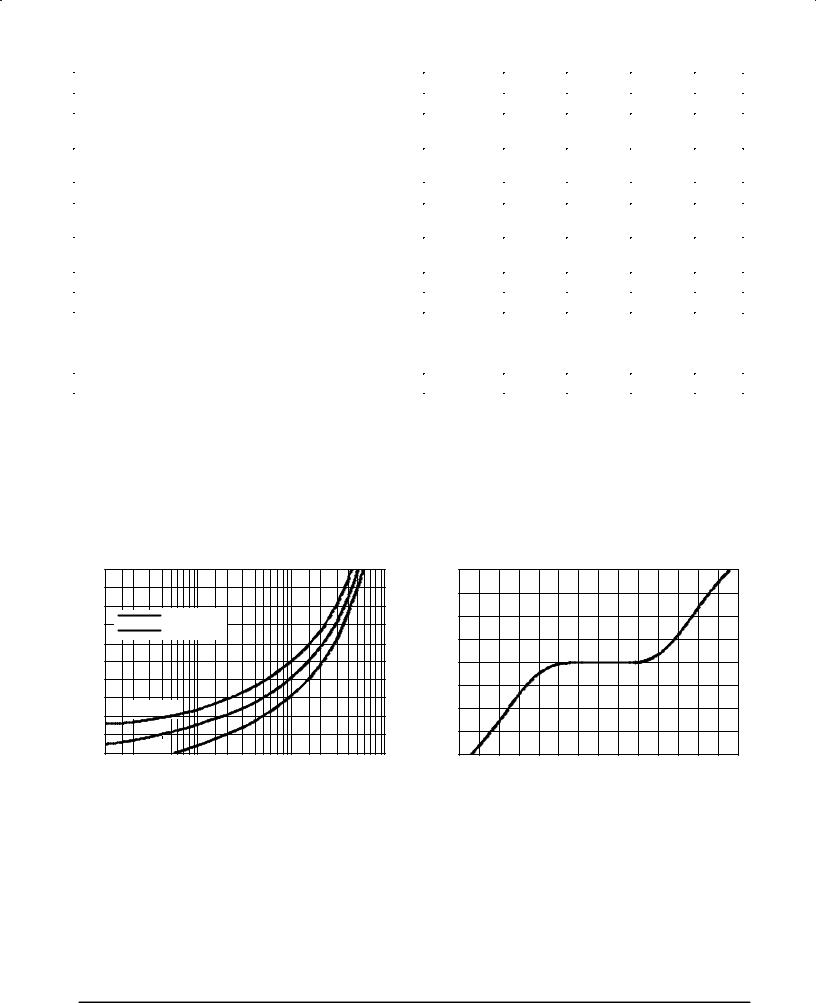
MOC3010 |
MOC3011 |
MOC3012 |
|
|
|
|
|
|
ELECTRICAL CHARACTERISTICS (TA = 25°C unless otherwise noted) |
|
|
|
|
|
|||
|
|
|
|
|
|
|
|
|
|
Characteristic |
|
Symbol |
Min |
Typ |
Max |
Unit |
|
|
|
|
|
|
|
|
|
|
INPUT LED |
|
|
|
|
|
|
|
|
|
|
|
|
|
|
|
|
|
Reverse Leakage Current |
|
|
IR |
Ð |
0.05 |
100 |
μA |
|
(VR = 3 V) |
|
|
|
|
|
|
|
|
Forward Voltage |
|
|
VF |
Ð |
1.15 |
1.5 |
Volts |
|
(IF = 10 mA) |
|
|
|
|
|
|
|
|
OUTPUT DETECTOR (IF = 0 unless otherwise noted) |
|
|
|
|
|
|||
Peak Blocking Current, Either Direction |
|
|
IDRM |
Ð |
10 |
100 |
nA |
|
(Rated V |
(1)) |
|
|
|
|
|
|
|
DRM |
|
|
|
|
|
|
|
|
Peak On±State Voltage, Either Direction |
|
|
VTM |
Ð |
1.8 |
3 |
Volts |
|
(ITM = 100 mA Peak) |
|
|
|
|
|
|
|
|
Critical Rate of Rise of Off±State Voltage (Figure 7, Note 2) |
|
dv/dt |
Ð |
10 |
Ð |
V/μs |
||
|
|
|
|
|
|
|
|
|
COUPLED |
|
|
|
|
|
|
|
|
|
|
|
|
|
|
|||
LED Trigger Current, Current Required to Latch Output |
|
IFT |
|
|
|
mA |
||
(Main Terminal Voltage = 3 V(3)) |
MOC3010 |
|
|
Ð |
8 |
15 |
|
|
|
|
MOC3011 |
|
|
Ð |
5 |
10 |
|
|
|
MOC3012 |
|
|
Ð |
3 |
5 |
|
|
|
|
|
|
|
|
|
|
Holding Current, Either Direction |
|
|
IH |
Ð |
100 |
Ð |
μA |
|
1.Test voltage must be applied within dv/dt rating.
2.This is static dv/dt. See Figure 7 for test circuit. Commutating dv/dt is a function of the load±driving thyristor(s) only.
3.All devices are guaranteed to trigger at an IF value less than or equal to max IFT. Therefore, recommended operating IF lies between max
3.IFT (15 mA for MOC3010, 10 mA for MOC3011, 5 mA for MOC3012) and absolute max IF (60 mA).
TYPICAL ELECTRICAL CHARACTERISTICS
TA = 25°C
|
2 |
|
|
|
(VOLTS) |
1.8 |
PULSE ONLY |
|
|
|
|
|
||
|
PULSE OR DC |
|
|
|
VOLTAGE |
|
|
|
|
1.6 |
|
|
|
|
|
|
|
|
|
FORWARD |
1.4 |
|
|
|
1.2 |
TA = ±40°C |
|
|
|
, |
|
|
|
|
F |
|
25°C |
|
|
V |
|
|
|
|
|
1 |
85°C |
|
|
|
1 |
10 |
100 |
1000 |
|
|
IF, LED FORWARD CURRENT (mA) |
|
|
Figure 1. LED Forward Voltage versus Forward Current
|
+800 |
|
|
|
|
|
|
(mA) |
+400 |
|
|
|
|
|
|
CURRENT |
|
|
|
|
|
|
|
0 |
|
|
|
|
|
|
|
, ON-STATE |
|
|
|
|
|
|
|
±400 |
|
|
|
|
|
|
|
TM |
|
|
|
|
|
|
|
I |
|
|
|
|
|
|
|
|
±800 |
|
|
|
|
|
|
|
±3 |
±2 |
±1 |
0 |
1 |
2 |
3 |
VTM, ON±STATE VOLTAGE (VOLTS)
Figure 2. On±State Characteristics
2 |
Motorola Optoelectronics Device Data |
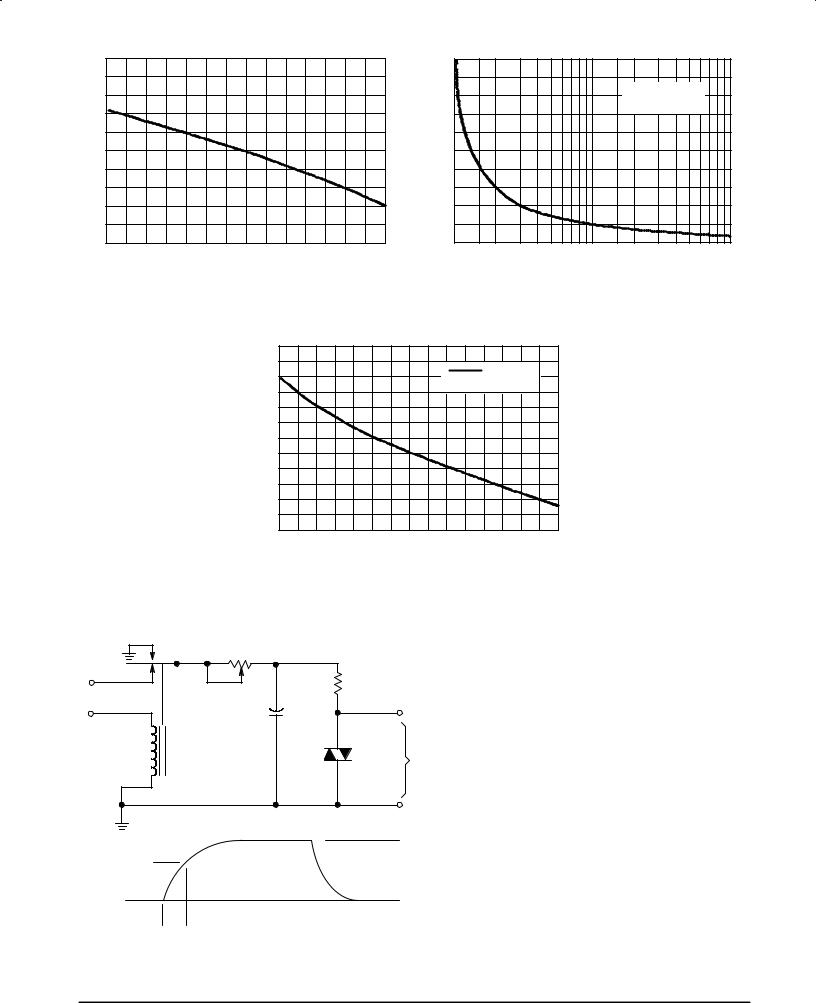
|
1.5 |
|
|
|
|
|
|
|
|
1.3 |
|
|
|
|
|
|
|
FT |
|
|
|
|
|
|
|
|
I |
|
|
|
|
|
|
|
|
NORMALIZED |
1.1 |
|
|
|
|
|
|
|
0.9 |
|
|
|
|
|
|
|
|
|
|
|
|
|
|
|
|
|
|
0.7 |
|
|
|
|
|
|
|
|
0.5 |
|
|
|
|
|
|
|
|
±40 |
±20 |
0 |
20 |
40 |
60 |
80 |
100 |
|
|
|
TA, AMBIENT TEMPERATURE (°C) |
|
|
|||
Figure 3. Trigger Current versus Temperature
|
|
MOC3010 |
MOC3011 |
MOC3012 |
|||
CURRENT |
25 |
|
|
|
|
|
|
20 |
|
|
|
NORMALIZED TO: |
|
||
|
|
|
PWin q 100 |
μs |
|
||
|
|
|
|
|
|||
LED TRIGGER |
|
|
|
|
|
||
15 |
|
|
|
|
|
|
|
10 |
|
|
|
|
|
|
|
, NORMALIZED |
|
|
|
|
|
|
|
5 |
|
|
|
|
|
|
|
|
|
|
|
|
|
|
|
FT |
0 |
|
|
|
|
|
|
I |
|
|
|
|
|
|
|
|
|
|
|
|
|
|
|
|
1 |
2 |
5 |
10 |
20 |
50 |
100 |
|
|
|
PWin, LED TRIGGER WIDTH (μs) |
|
|
||
Figure 4. LED Current Required to Trigger versus LED Pulse Width
|
12 |
|
|
|
|
|
|
|
|
|
10 |
|
|
|
|
|
STATIC dv/dt |
|
|
|
|
|
|
|
CIRCUIT IN FIGURE 6 |
|
|||
μs) |
|
|
|
|
|
|
|||
|
|
|
|
|
|
|
|
|
|
(V/ |
8 |
|
|
|
|
|
|
|
|
dv/dt, STATIC |
6 |
|
|
|
|
|
|
|
|
4 |
|
|
|
|
|
|
|
|
|
|
|
|
|
|
|
|
|
|
|
|
2 |
|
|
|
|
|
|
|
|
|
0 |
|
|
|
|
|
|
|
|
|
25 |
30 |
40 |
50 |
60 |
70 |
80 |
90 |
100 |
|
|
|
|
TA, AMBIENT TEMPERATURE (°C) |
|
|
|||
Figure 5. dv/dt versus Temperature
+250 |
|
|
|
Vdc |
RTEST |
|
R = 10 kΩ |
|
|
|
|
PULSE |
|
CTEST |
|
INPUT |
MERCURY |
|
X100 |
|
WETTED |
|
|
|
|
SCOPE |
|
|
RELAY |
D.U.T. |
|
|
PROBE |
||
|
|
||
|
|
|
APPLIED VOLTAGE |
158 V |
WAVEFORM |
0 VOLTS

 tRC
tRC
1.The mercury wetted relay provides a high speed repeated pulse to the D.U.T.
2.100x scope probes are used, to allow high speeds and voltages.
3.The worst±case condition for static dv/dt is established by triggering the D.U.T. with a normal LED input current, then
removing the current. The variable RTEST allows the dv/dt to be gradually increased until the D.U.T. continues to trigger in response to the applied voltage pulse, even after the LED current has been removed. The dv/dt is then decreased until
the D.U.T. stops triggering. tRC is measured at this point and recorded.
Vmax = 250 V
0.63 Vmax |
158 |
||
dv dt + |
|
|
+ tRC |
tRC |
|||
Figure 6. Static dv/dt Test Circuit
Motorola Optoelectronics Device Data |
3 |
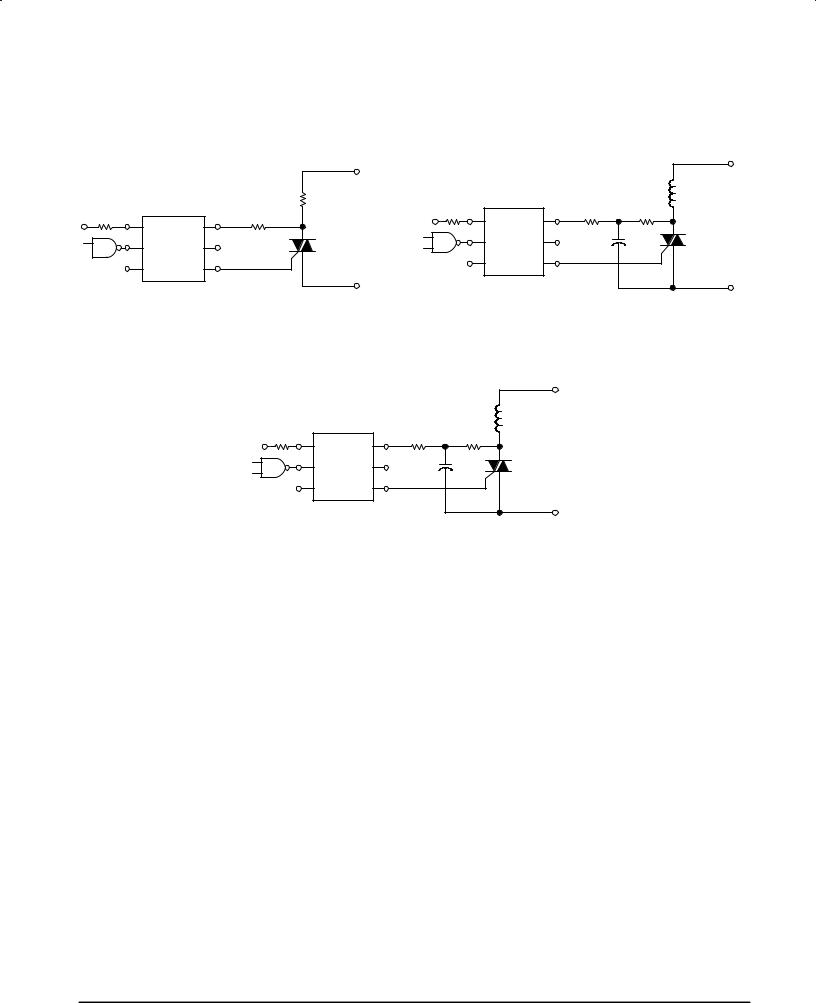
MOC3010 MOC3011 MOC3012
TYPICAL APPLICATION CIRCUITS
NOTE: This optoisolator should not be used to drive a load directly. It is intended to be a trigger device only. Additional information on the use of the MOC3010/3011/3012 is available in Application Note AN±780A.
|
|
|
|
|
|
RL |
|
|
|
|
|
|
|
ZL |
|
|
|
|
|
|
VCC |
Rin |
1 |
|
6 |
180 |
2.4 k |
|
|
VCC |
Rin |
1 |
|
6 |
180 |
|
|
120 V |
||||||
|
|
120 V |
|
MOC3010 |
|
|
||||||||
|
|
|
MOC3010 |
|
|
|
60 Hz |
|
2 |
|
|
|
60 Hz |
|
|
|
2 |
|
|
|
|
MOC3011 |
|
0.1 μF |
C1 |
||||
|
|
MOC3011 |
|
|
|
|
|
|
|
|
||||
|
|
|
|
|
|
|
|
|
MOC3012 |
4 |
|
|
|
|
|
|
|
MOC3012 |
4 |
|
|
|
|
|
|
|
|
||
|
|
|
|
|
|
|
|
|
|
|
|
|||
|
|
|
|
|
|
|
|
|
|
|
|
|
Figure 7. Resistive Load |
Figure 8. Inductive Load with Sensitive Gate Triac |
(IGT p 15 mA)
VCC Rin 1
2
|
|
|
|
ZL |
MOC3010 |
6 |
180 |
1.2 k |
120 V |
|
|
|
60 Hz |
|
MOC3011 |
|
0.2 μF |
C1 |
|
MOC3012 |
4 |
|
|
|
|
|
|
|
Figure 9. Inductive Load with Non±Sensitive Gate Triac (15 mA t IGT t 50 mA)
4 |
Motorola Optoelectronics Device Data |
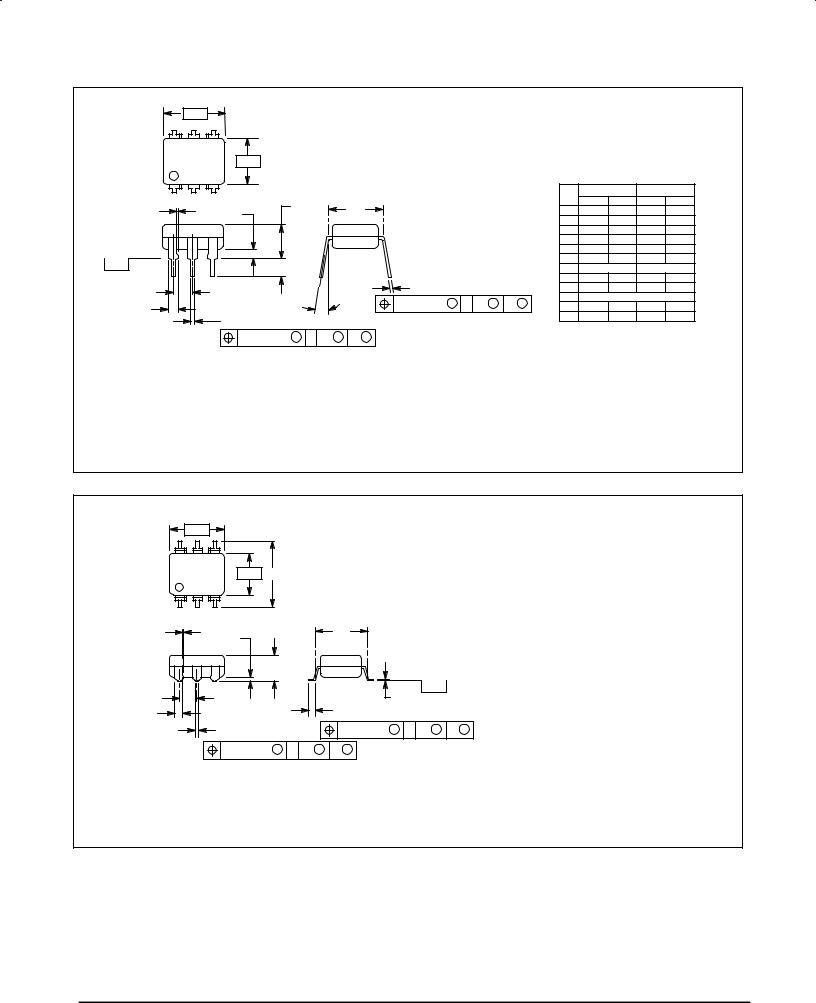
|
|
MOC3010 |
MOC3011 |
MOC3012 |
|||||
|
|
PACKAGE DIMENSIONS |
|
|
|
|
|
|
|
|
±A± |
|
|
|
|
|
|
|
|
|
|
|
NOTES: |
|
|
|
|
|
|
6 |
4 |
|
1. DIMENSIONING AND TOLERANCING PER ANSI |
||||||
|
Y14.5M, 1982. |
|
|
|
|
||||
|
|
|
|
|
|
|
|||
|
±B± |
|
2. CONTROLLING DIMENSION: INCH. |
|
|||||
1 |
3 |
|
3. DIMENSION L TO CENTER OF LEAD WHEN |
||||||
|
FORMED PARALLEL. |
|
|
|
|||||
|
|
|
|
INCHES |
|
MILLIMETERS |
|||
F 4 PL |
C |
L |
DIM |
MIN |
MAX |
MIN |
MAX |
||
A |
0.320 |
0.350 |
8.13 |
8.89 |
|||||
N |
|||||||||
|
|
B |
0.240 |
0.260 |
6.10 |
6.60 |
|||
|
|
|
|||||||
|
|
|
C |
0.115 |
0.200 |
2.93 |
5.08 |
||
|
|
|
D |
0.016 |
0.020 |
0.41 |
0.50 |
||
|
|
|
E |
0.040 |
0.070 |
1.02 |
1.77 |
||
±T± |
K |
|
F |
0.010 |
0.014 |
0.25 |
0.36 |
||
|
G |
0.100 BSC |
|
2.54 BSC |
|||||
SEATING |
|
|
|||||||
|
|
J |
0.008 |
0.012 |
0.21 |
0.30 |
|||
PLANE |
G |
J 6 PL |
K |
0.100 |
0.150 |
2.54 |
3.81 |
||
|
|||||||||
|
0.13 (0.005) M T B M A M |
L |
0.300 BSC |
|
7.62 BSC |
||||
|
M |
|
|||||||
E 6 PL |
M |
0 |
15 |
0 |
15 |
||||
D 6 PL |
|
N |
0.015 |
0.100 |
0.38 |
2.54 |
|||
|
|
||||||||
|
|
|
|
|
|
|
|
||
|
0.13 (0.005) M T A |
M B M |
|
STYLE 6: |
|
|
|
||
|
|
|
|
PIN 1. |
ANODE |
|
|||
|
|
|
|
|
2. |
CATHODE |
|
||
|
|
|
|
|
3. |
NC |
|
|
|
|
|
|
|
|
4. |
MAIN TERMINAL |
|||
|
|
|
|
|
5. |
SUBSTRATE |
|
||
|
|
|
|
|
6. |
MAIN TERMINAL |
|||
CASE 730A±04
ISSUE G
±A± |
6 |
4 |
|
|
|
±B± S |
|
|
1 |
3 |
|
|
F 4 PL |
H |
L |
|
|
|
|
|
|
C |
|
|
|
G |
J |
±T± |
|
SEATING |
||
E 6 PL |
|
K 6 PL |
PLANE |
|
|
||
|
D 6 PL |
0.13 (0.005) M |
T B M A M |
|
0.13 (0.005) M T A M |
B M |
|
NOTES:
1.DIMENSIONING AND TOLERANCING PER ANSI Y14.5M, 1982.
2.CONTROLLING DIMENSION: INCH.
|
INCHES |
MILLIMETERS |
||
DIM |
MIN |
MAX |
MIN |
MAX |
A |
0.320 |
0.350 |
8.13 |
8.89 |
B |
0.240 |
0.260 |
6.10 |
6.60 |
C |
0.115 |
0.200 |
2.93 |
5.08 |
D |
0.016 |
0.020 |
0.41 |
0.50 |
E |
0.040 |
0.070 |
1.02 |
1.77 |
F |
0.010 |
0.014 |
0.25 |
0.36 |
G |
0.100 BSC |
2.54 BSC |
||
H |
0.020 |
0.025 |
0.51 |
0.63 |
J |
0.008 |
0.012 |
0.20 |
0.30 |
K |
0.006 |
0.035 |
0.16 |
0.88 |
L |
0.320 BSC |
8.13 BSC |
||
S |
0.332 |
0.390 |
8.43 |
9.90 |
*Consult factory for leadform
option availability
CASE 730C±04
ISSUE D
Motorola Optoelectronics Device Data |
5 |
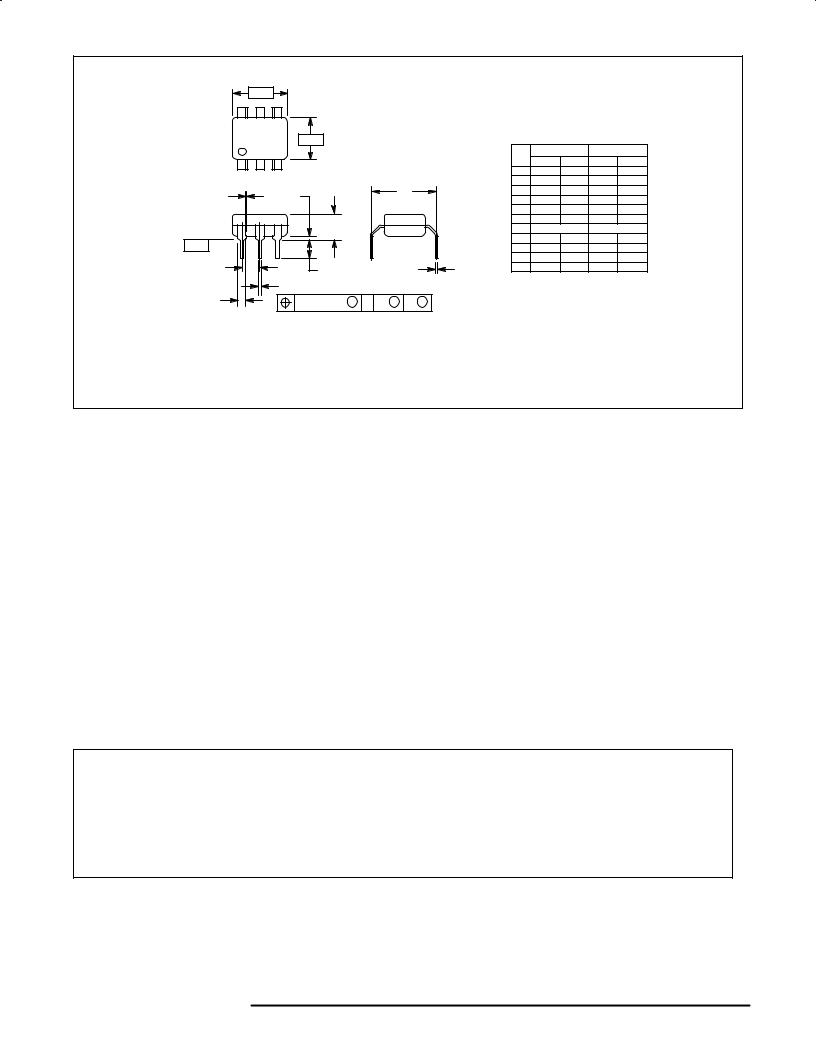
MOC3010 MOC3011 MOC3012
|
±A± |
NOTES: |
|
|
|
1. |
DIMENSIONING AND TOLERANCING PER ANSI |
|
|
|
Y14.5M, 1982. |
6 |
4 |
2. |
CONTROLLING DIMENSION: INCH. |
3. |
DIMENSION L TO CENTER OF LEAD WHEN |
||
|
|
±B± |
FORMED PARALLEL. |
|
|
|
|
1 |
3 |
|
|
|
|
INCHES |
MILLIMETERS |
||
|
|
|
|
|
DIM |
MIN |
MAX |
MIN |
MAX |
|
|
|
|
|
A |
0.320 |
0.350 |
8.13 |
8.89 |
|
|
|
L |
|
B |
0.240 |
0.260 |
6.10 |
6.60 |
F 4 PL |
|
N |
|
C |
0.115 |
0.200 |
2.93 |
5.08 |
|
|
|
|
D |
0.016 |
0.020 |
0.41 |
0.50 |
||
|
|
|
|
|
E |
0.040 |
0.070 |
1.02 |
1.77 |
|
|
|
C |
|
F |
0.010 |
0.014 |
0.25 |
0.36 |
|
|
|
|
G |
0.100 BSC |
2.54 BSC |
|||
±T± |
|
|
|
|
J |
0.008 |
0.012 |
0.21 |
0.30 |
|
|
|
|
K |
0.100 |
0.150 |
2.54 |
3.81 |
|
SEATING |
|
|
|
|
L |
0.400 |
0.425 |
10.16 |
10.80 |
PLANE |
G |
|
K |
J |
N |
0.015 |
0.040 |
0.38 |
1.02 |
|
|
||||||||
|
D 6 PL |
|
|
|
|
|
|
||
E 6 PL |
|
|
0.13 (0.005) M T A M B |
M |
|
|
|
|
|
*Consult factory for leadform option availability
CASE 730D±05
ISSUE D
Motorola reserves the right to make changes without further notice to any products herein. Motorola makes no warranty, representation or guarantee regarding the suitability of its products for any particular purpose, nor does Motorola assume any liability arising out of the application or use of any product or circuit, and specifically disclaims any and all liability, including without limitation consequential or incidental damages. ªTypicalº parameters can and do vary in different applications. All operating parameters, including ªTypicalsº must be validated for each customer application by customer's technical experts. Motorola does not convey any license under its patent rights nor the rights of others. Motorola products are not designed, intended, or authorized for use as components in systems intended for surgical implant into the body, or other applications intended to support or sustain life, or for any other application in which the failure of the Motorola product could create a situation where personal injury or death may occur. Should Buyer purchase or use Motorola products for any such unintended or unauthorized application, Buyer shall indemnify and hold Motorola and its officers, employees, subsidiaries, affiliates, and distributors harmless against all claims, costs, damages, and expenses, and reasonable attorney fees arising out of, directly or indirectly, any claim of personal injury or death associated with such unintended or unauthorized use, even if such claim alleges that Motorola was negligent regarding the design or manufacture of the part. Motorola and  are registered trademarks of Motorola, Inc. Motorola, Inc. is an Equal Opportunity/Affirmative Action Employer.
are registered trademarks of Motorola, Inc. Motorola, Inc. is an Equal Opportunity/Affirmative Action Employer.
How to reach us: |
|
USA / EUROPE: Motorola Literature Distribution; |
JAPAN: Nippon Motorola Ltd.; Tatsumi±SPD±JLDC, Toshikatsu Otsuki, |
P.O. Box 20912; Phoenix, Arizona 85036. 1±800±441±2447 |
6F Seibu±Butsuryu±Center, 3±14±2 Tatsumi Koto±Ku, Tokyo 135, Japan. 03±3521±8315 |
MFAX: RMFAX0@email.sps.mot.com ± TOUCHTONE (602) 244±6609 HONG KONG: Motorola Semiconductors H.K. Ltd.; 8B Tai Ping Industrial Park, |
|
INTERNET: http://Design±NET.com |
51 Ting Kok Road, Tai Po, N.T., Hong Kong. 852±26629298 |
◊ MOC3010/D
*MOC3010/D*
